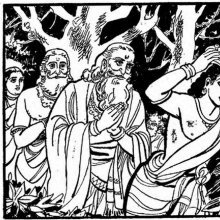Nandigrama, Nandigrāma, Nandi-grama: 10 definitions
Introduction:
Nandigrama means something in Hinduism, Sanskrit, Jainism, Prakrit, the history of ancient India. If you want to know the exact meaning, history, etymology or English translation of this term then check out the descriptions on this page. Add your comment or reference to a book if you want to contribute to this summary article.
Images (photo gallery)
In Hinduism
Purana and Itihasa (epic history)
Source: archive.org: Puranic EncyclopediaNandigrāma (नन्दिग्राम).—It is stated in Vālmīki Rāmāyaṇa, Ayodhyākāṇḍa that while Śrī Rāma had been leading forest life, Bharata lived in Nandigrāma for twelve years worshipping the sandals of Śrī Rāma. This Nandigrāma is situated nearly fourteen miles away from Ayodhyā. (Faizabad).
Source: Cologne Digital Sanskrit Dictionaries: The Purana IndexNandigrāma (नन्दिग्राम).—The place where Bharata lived during Rāma's exile.*
- * Bhāgavata-purāṇa IX. 10. 36.

The Purana (पुराण, purāṇas) refers to Sanskrit literature preserving ancient India’s vast cultural history, including historical legends, religious ceremonies, various arts and sciences. The eighteen mahapuranas total over 400,000 shlokas (metrical couplets) and date to at least several centuries BCE.
In Jainism
General definition (in Jainism)
Source: archive.org: TrisastisalakapurusacaritraNandigrāma (नन्दिग्राम) is the name of an ancient village, according to chapter 1.1 [ādīśvara-caritra] of Hemacandra’s 11th century Triṣaṣṭiśalākāpuruṣacaritra: an ancient Sanskrit epic poem narrating the history and legends of sixty-three illustrious persons in Jainism.
Source: HereNow4u: Lord Śrī MahāvīraNandigrāma (नन्दिग्राम) is the name of a village visited by Mahāvīra during his twelfth year of spiritual-exertion.—From Suṃsumārapura the Lord reached Bhojapura, Nandigrāma and Meḍhiyāgrāma. From Meḍhiyāgrāma he reached Kauśāmbī.

Jainism is an Indian religion of Dharma whose doctrine revolves around harmlessness (ahimsa) towards every living being. The two major branches (Digambara and Svetambara) of Jainism stimulate self-control (or, shramana, ‘self-reliance’) and spiritual development through a path of peace for the soul to progess to the ultimate goal.
India history and geography
Source: Ancient Buddhist Texts: Geography of Early BuddhismNandigrāma (नन्दिग्राम) or Naṃdinagara is the name of an ancient locality situated in Majjhimadesa (Middle Country) of ancient India, as recorded in the Pāli Buddhist texts (detailing the geography of ancient India as it was known in to Early Buddhism).—Nandigrāma is mentioned in the Barhut inscriptions. The location of the place is unknown. If it be the same as Nandigrāma of the Rāmāyaṇa, then it may be identical with Nandgaon in Oudh.

The history of India traces the identification of countries, villages, towns and other regions of India, as well as mythology, zoology, royal dynasties, rulers, tribes, local festivities and traditions and regional languages. Ancient India enjoyed religious freedom and encourages the path of Dharma, a concept common to Buddhism, Hinduism, and Jainism.
Languages of India and abroad
Sanskrit dictionary
Source: DDSA: The practical Sanskrit-English dictionaryNandigrāma (नन्दिग्राम).—Name of a village near Daulatabad where Bharata lived during Rāma's banishment; नन्दिग्रामगतस्तस्य राज्यं न्यासमिवाभुनक् (nandigrāmagatastasya rājyaṃ nyāsamivābhunak) R.12.18.
Derivable forms: nandigrāmaḥ (नन्दिग्रामः).
Nandigrāma is a Sanskrit compound consisting of the terms nandi and grāma (ग्राम).
Source: Cologne Digital Sanskrit Dictionaries: Cappeller Sanskrit-English DictionaryNandigrāma (नन्दिग्राम).—[masculine] [Name] of a village.
Source: Cologne Digital Sanskrit Dictionaries: Monier-Williams Sanskrit-English DictionaryNandigrāma (नन्दिग्राम):—[=nandi-grāma] [from nandi > nand] m. Name of a village near Daulatābād (where Bharata resided during Rāma’s banishment), [Mahābhārata; Kāvya literature] etc.
[Sanskrit to German]
Sanskrit, also spelled संस्कृतम् (saṃskṛtam), is an ancient language of India commonly seen as the grandmother of the Indo-European language family (even English!). Closely allied with Prakrit and Pali, Sanskrit is more exhaustive in both grammar and terms and has the most extensive collection of literature in the world, greatly surpassing its sister-languages Greek and Latin.
See also (Relevant definitions)
Partial matches: Grama, Nandi, Nanti.
Starts with: Nandigramadarshana.
Full-text: Nandigramadarshana, Nantikkiramam, Ananta daivajna, Bhojapura, Nandinagara, Sumsumarapura, Ayodhya, Ganeshvara acarya, Ganesha daivajna, Khagola, Vinirnaya, Bhugola, Jyotishcakra, Keshava daivajna, Medhiyagrama, Gotrapravaranirnaya, Bharata.
Relevant text
Search found 18 books and stories containing Nandigrama, Nandi-grama, Nandi-grāma, Nandigrāma; (plurals include: Nandigramas, gramas, grāmas, Nandigrāmas). You can also click to the full overview containing English textual excerpts. Below are direct links for the most relevant articles:
Garga Samhita (English) (by Danavir Goswami)
Verse 4.19.122 < [Chapter 19 - A Thousand Names of Srī Yamunā]
Ramayana of Valmiki (by Hari Prasad Shastri)
Chapter 115 - Prince Bharata retires to Nandigrama < [Book 2 - Ayodhya-kanda]
Chapter 62 - Shatrughna asks permission to fight Lavana < [Book 7 - Uttara-kanda]
Chapter 130 - Bharata sets out to meet Rama < [Book 6 - Yuddha-kanda]
Rudra-Shiva concept (Study) (by Maumita Bhattacharjee)
27. Vaiśyanātha incarnation < [Chapter 5 - Rudra-Śiva in the Purāṇic Literature]
The Padma Purana (by N.A. Deshpande)
Chapter 1 - Rāma Sees Nandigrāma from Puṣpaka < [Section 5 - Pātāla-Khaṇḍa (Section on the Nether World)]
Chapter 2 - Rāma Meets Bharata < [Section 5 - Pātāla-Khaṇḍa (Section on the Nether World)]
Chapter 36 - Lomaśa Narrates the Deeds of Rāma to Āraṇyaka < [Section 5 - Pātāla-Khaṇḍa (Section on the Nether World)]
Ramayana (by Manmatha Nath Dutt)
The Shiva Purana (by J. L. Shastri)
Chapter 26 - Śiva’s incarnation as Vaiśyanātha < [Section 3 - Śatarudra-saṃhitā]
